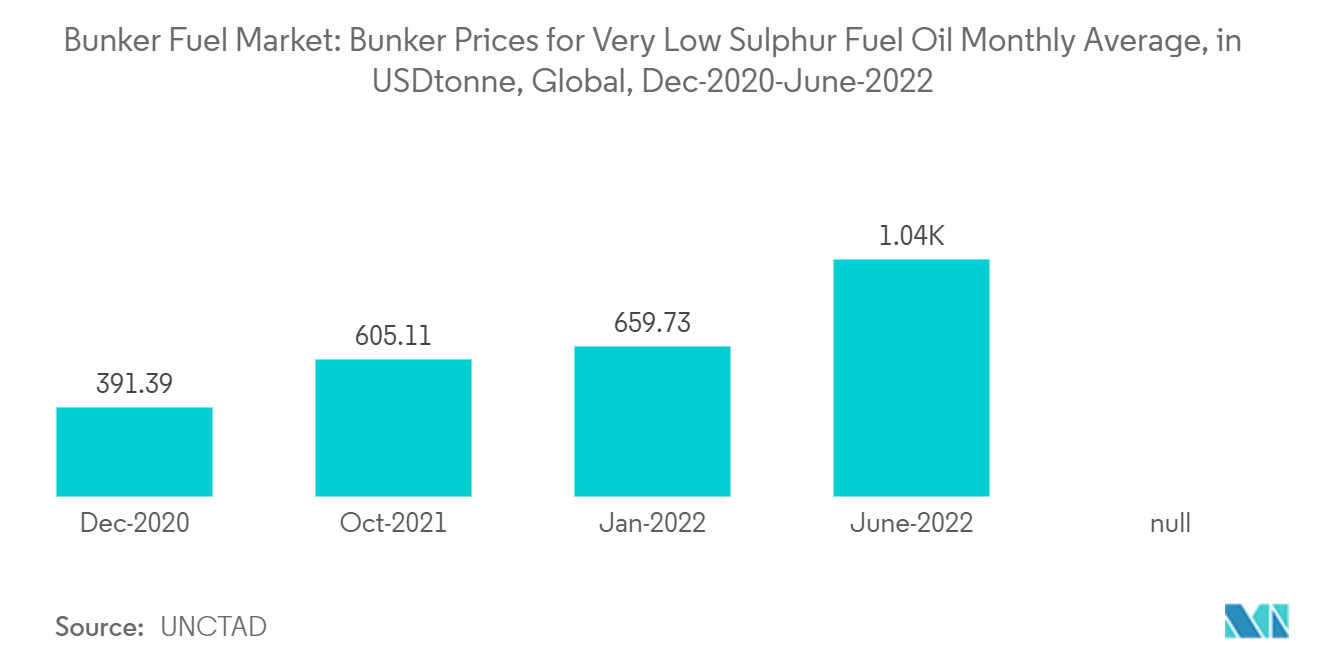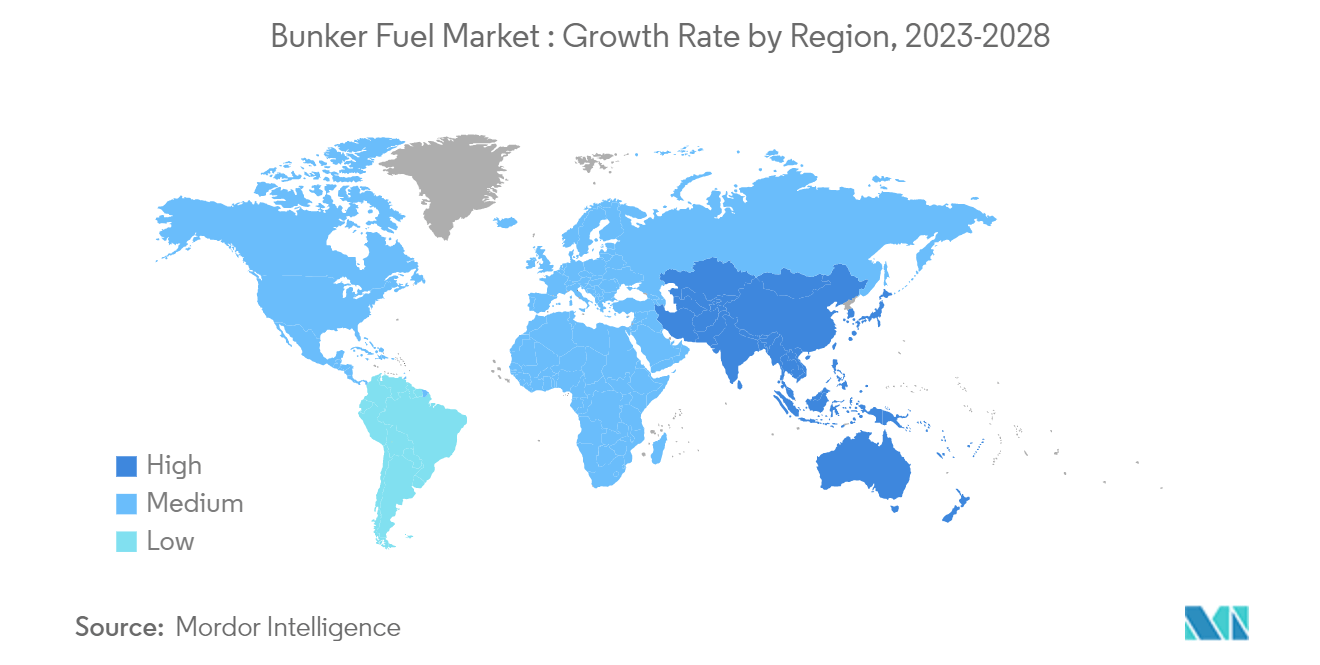Market Trends of Bunker Fuel Industry
LNG as a Bunker Fuel is Likely to Witness Significant Growth
- The global LNG bunkering market evolved over the past decade, driven by the growth in global LNG usage, clean energy demand, and its ability to reduce greenhouse gas emissions. The order and delivery of LNG-powered vessels are increasing, and the reduced natural gas prices in 2014 marked the beginning of expanding opportunities for such vessels.
- The conversion of the current operating vessels into LNG-based vessels is highly expensive. Hence, it is not economically viable. However, the operational cost of LNG-based vessels is expected to be least among all the fuel alternatives, once the new emission regulations become applicable. Further, a gradual shift to LNG for propulsion is more advantageous, as compared to the traditional methods of fueling ships with heavy fuel oil, marine gas oil, marine diesel oil, etc. LNG-based propulsion reduces carbon footprint significantly and increases the ship's operational efficiency.
- The LNG bunkering industry also registered significant investments in infrastructure construction, and as of January 2022, there are 33 LNG bunkering vessels and 141 LNG ports operational, and further 170 LNG ports to be expected to be operational by the end of 2022. As a result, the ship owners, particularly the ones that are operating in the European or American Sea, now prefer LNG-based vessels over conventional vessels. Furthermore, the LNG fueled ships have not penetrated the market for bulk carriers to a significant extent, as these ships are designed to carry heavy loads, and LNG technology is relatively new to apply for this type of vessels. The bulk carriers amount to the largest share of the in-operation ships.
- Furthermore, the demand for LSFO has been on the positive side due to the low sulfur restriction that has spurred demand since January 2020. Moreover, the use of LNG as a fuel is both a proven and commercially available solution. LNG offers enormous advantages, especially for ships in the light of ever-tightening emission regulations. Conventional oil-based fuels are expected to remain the primary fuel option for most ships in the mid-term, while LNG is likely to become a popular choice in the long-term scenario. In June 2022, the bunker prices for very low sulphur fuel oil (VLSFO) USD 1,043.84 per tonne (monthly average).
- For instance, in May 2022, Titan LNG and Brittany Ferries have signed a long-term bunkering agreement for the supply of LNG and Liquefied Bio Methane (LBM) to two new LNG fueled hybrid Ro-Pax vessels that Brittany Ferries is likely to operate between England and France from 2025. These vessels are expected to serve established routes connecting Portsmouth with Saint-Malo, and Portsmouth with Ouistreham. Also, Titans aims to supply fuel to both vessels during usual cargo operations alongside SIMOPS (simultaneous operations).
- The LNG demand is likely to increase significantly in the forecast period as the orderbook for LNG vessels continues to increase, relatively cheaper than conventional fuels, offers 23% cut in greenhouse gas emissions over oil-based marine fuel which will aid to meet the global decarbonization goals making it the most popular marine fuel in the future.

Asia-Pacific is Expected to Dominate the Market
- Asia-Pacific is expected to dominate the bunker fuel market due to the immense maritime trade potential of countries like India, China, Singapore, Japan, and other countries.
- As of 2022, China ranks first for exporter goods and second for imported goods by value. China's major exports are mechanical and electric machinery and equipment, automotive products, including vehicle parts, chemicals and plastics, iron and steel articles, furniture, etc.
- Further, the fleet in the country is registering a situation of drastic oversupply. According to the Ministry of Transport of the People's Republic of China, in 2021, Shanghai port topped in the container throughput, reaching over 47.03 million TEU witnessing an increase of 8.1% compared to 2020 levels.
- Australia is among the biggest exporter of LNG globally. The rising LNG exports supported the international trade of Australia.The export volume is likely to go up in the coming years as the demand for LNG is increasing significantly across the globe.
- To increase the share of the marine sector in international and domestic trade, the Indian government announced an investment of USD 22 billion by 2035 to modernize the existing ports and build new ports. The port infrastructure development is expected to increase the demand from the maritime industry and marine fuel suppliers in Asia-Pacific during the forecast period.
- In March 2022, the first marine bio-VLSFO (very low sulfur fuel oil) bunker delivery was carried out by TotalEnergies Marine Fuels at Singapore port's waters. The delivery was part of NYK Line and Anglo American's recently completed biofuel trial. The delivery was supplied to the MT Friendship via a ship-to-ship transfer and consisted of a B10 biofuel blend made up of VLSFO blended with 10% second-generation, waste-based and ISCC-certified UCOME (used cooking oil methyl ester). The biofuel was used during the vessel's two-way trip between Singapore and Saldanha Bay in South Africa.
- Therefore, based on the aforementioned factors, Asia-Pacific is expected to dominate the bunker fuel market during the forecast period.

